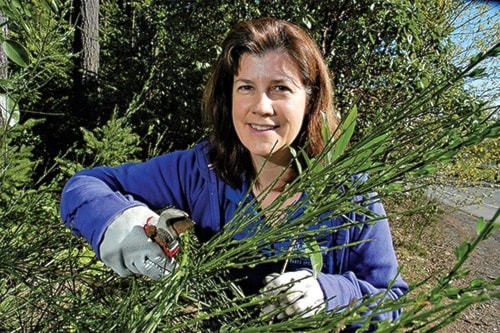There are aliens living among us, and the city's parks and recreation department has a plan to get rid of them.
English ivy, daphne, Himalayan blackberry, giant hogweed and the ubiquitous scotch broom are just a few of the invasive species being targeted during May, designated as Invasive Plant Awareness Month in Nanaimo.
To help reduce the spread of these invaders, no matter how pretty they appear, city staff have developed a number of invasive species removal events throughout the month to encourage residents to participate in removing the plants from roadsides, parks and other areas where they are choking out native vegetation.
“The biggest thing is these plants are affecting the natural ecosystem by dominating the plants that would naturally grow here,” said Deborah Beck, recreation coordinator for the city. “The Himalayan blackberry takes over from native blackberries, which generate berries in the spring and allow birds to feed on them. Himalayans produce fruit in the fall, which is great for us but not so much for the birds that really need it in the spring.”
According to the city's invasive plant reduction strategy, the uncontrolled spread of these invaders are becoming a major concern for ecologists, naturalists, residents and land managers across B.C. These plants often thrive because of a lack of natural predators and easily out-compete native plants. If allowed to establish, they can diminish local biodiversity, reduce habitat and food sources for other species, and, in the case of giant hogweed and even daphne, can cause personal injury to people or pets from the toxins they emit.
“We may not be able to eliminate the plant, especially for a species like scotch broom, but we can at least control it,” said Beck.
People can also take a proactive approach to the spread of invasive species by being careful about how they dispose of their nursery or potted plants.
The city has partnered with local businesses and organizations, including Woodgrove Centre, Nanaimo North Town Centre, Nanaimo Fire Rescue and Nanaimo Recycling Exchange, to provide drop zones for piles of pulled plants. Harmac mill is also taking part by receiving piles of invasive plants from the city it will use in its products.
On May 14-15, Beck is working with environment clubs in local high schools to use scheduled professional development days to organize invasive species removal parties in an effort to educate students on the issue.
Neighbours that want to get together and register their own work parties are invited to do so, and programs such as the city's Volunteers in Parks will also be employed for park ambassadors to remove invasive plants from city property.
Drop zones (for invasive plants only) and the dates they are available, as well as scheduled work parties, can be found at www.nanaimo.ca/goto/invasives, and registration for neighbourhood work parties can be completed by calling 250-756-5200.
A complete list of invasive plant species and their characteristics, as well as effective methods to remove them, can also be found on the website.
